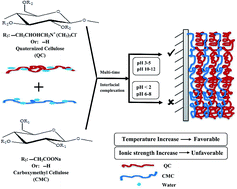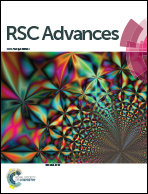Interfacial complexation behavior of anionic and cationic cellulose derivatives
Abstract
The oppositely charged cellulose derivatives, quaternized cellulose (QC) and carboxymethyl cellulose (CMC), were alternately deposited on silicon or quartz substrates by interfacial complexation, i.e. layer-by-layer (LbL) assembly, to prepare thin films. The effects of pH value, ionic strength and temperature on thin-film growth and morphology were investigated. The main chains of QC and CMC, composed of glucose rings, are hydrophilic and rigid, and hence QC and CMC show a different assembly behavior compared with synthetic vinyl polyelectrolytes such as polystyrene sulfonate and poly(diallyldimethyl-ammonium). As the pH value increases, in the region from pH 3 to pH 5, QC and CMC can be LbL-assembled to prepare thin films; in the neutral pH region, it is very difficult to assemble QC and CMC; and when the pH value is higher than 10, QC and CMC can again be deposited to fabricate thin films. The LbL assembly of QC and CMC is sensitive to ionic strength. On adding 0.1 M NaCl into the assembling solution, the thin-film growth decreases enormously. Increasing the temperature accelerates the growth in thickness of the films.


 Please wait while we load your content...
Please wait while we load your content...